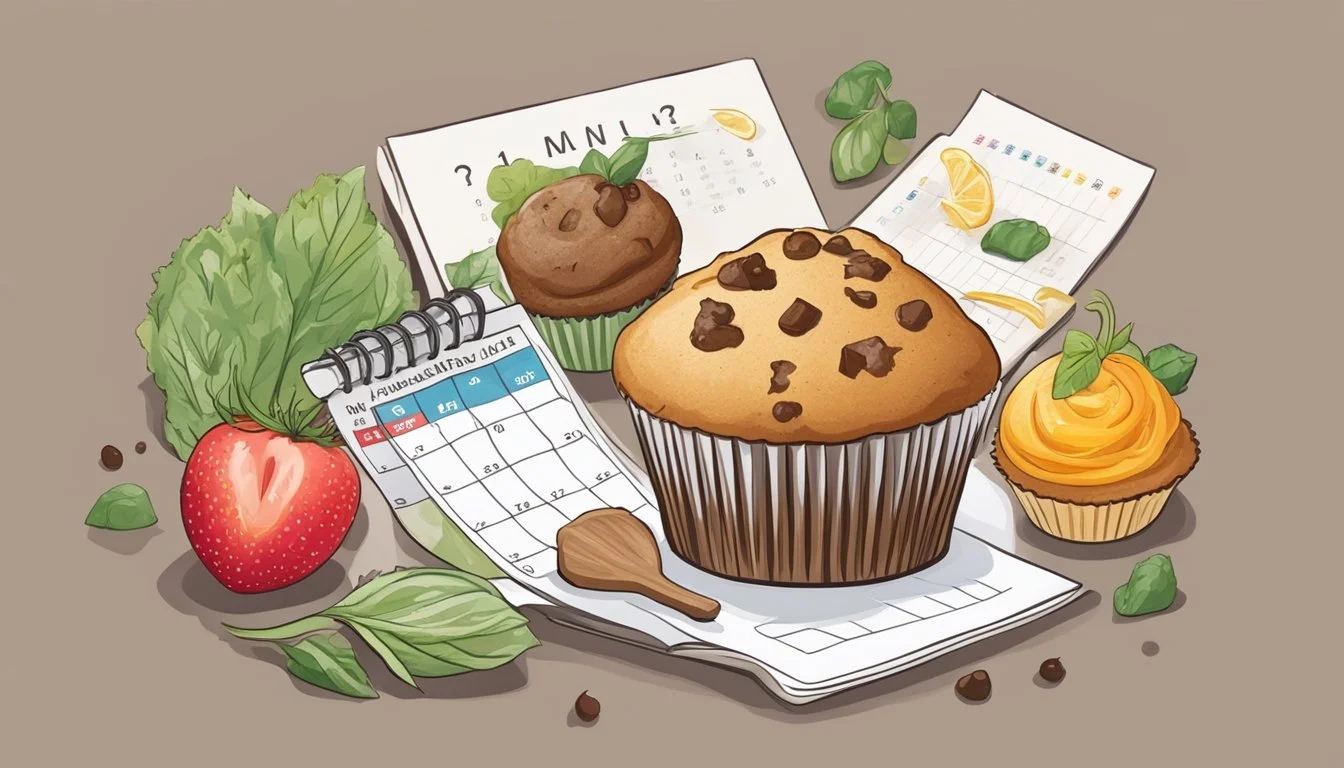Do Muffins Go Bad?
Understanding Shelf Life and Storage Tips
Muffins are a delightful treat enjoyed by many, but like all baked goods, they have a shelf life. Typically, muffins last anywhere from two to seven days, depending on their ingredients and storage conditions. Muffins with fresh fruit tend to spoil faster than those made with dry ingredients or without additives.
Proper storage can extend the life of your muffins considerably. Storing them in an airtight container at room temperature is often the best method for maintaining freshness. Refrigeration is generally not recommended as it can dry out the muffins, although freezing is a viable option for long-term storage.
Knowing how to identify when muffins have gone bad is crucial. Signs include unusual smell, mold, and changes in texture. Freezing could extend their longevity up to three months if done properly, ensuring that you can enjoy a tasty muffin whenever you want.
Understanding Muffin Freshness
Muffin freshness can be judged by various indicators such as taste, texture, and smell. Additionally, certain factors affect how long muffins stay fresh and delicious.
Determining Freshness
To determine if muffins are fresh, consider aspects like taste, texture, smell, and appearance. Fresh muffins are often moist and flavorful. If they give off a funky or off smell, they likely have gone bad.
Another sign is mold, which generally appears as blue, green, or gray spots on the surface. Also, any discoloration or odd coloring is a red flag. Finally, stale or dry texture signifies that the muffin is no longer at its optimum quality.
Factors Affecting Muffin Longevity
Several elements contribute to the shelf life of muffins. Ingredients play a crucial role; muffins with fresh fruit, cream, or dairy spoil faster than those made with dried or preserved ingredients.
Storage conditions also heavily influence freshness. Storing muffins in a cool, dry place away from direct sunlight helps maintain their quality.
Using airtight containers or bread boxes can extend muffin shelf life by maintaining moisture and preventing them from drying out. Reheating methods like oven warming at 350°F for about 10 minutes can help revive their delicious texture without compromising taste.
Proper Storage Techniques
Understanding the best ways to store muffins helps keep them fresh and delicious for longer. Whether placing them at room temperature, refrigerating, or freezing, each method requires specific steps to prevent them from going bad.
At Room Temperature
Storing muffins at room temperature is suitable for short-term storage. First, ensure the muffins are completely cool before storage to prevent moisture build-up, which can lead to sogginess. Place the muffins in an airtight container and line the bottom with a paper towel. This helps absorb any moisture released by the muffins.
For best results, keep the container in a cool, dry place away from direct sunlight and heat sources. On the counter, muffins generally stay fresh for up to two to three days.
Refrigerating Muffins
Refrigeration extends the shelf life of muffins up to a week. Begin by allowing the muffins to cool completely. Use an airtight container lined with a paper towel, then place a single layer of muffins inside.
Seal the container securely with its lid. Store the container in the refrigerator, ensuring it is away from strong-smelling foods to prevent the muffins from absorbing odors. Muffins stored this way should be consumed within four to five days for optimal taste.
Freezing and Thawing
For long-term storage, freezing muffins is the best option. Cool the muffins completely before wrapping them individually in plastic wrap or aluminum foil. This prevents freezer burn and keeps the muffins moist.
Place the wrapped muffins into a freezer-safe bag or an airtight container. Label the bag with the date for easy tracking. Muffins can be stored in the freezer for up to three months. When ready to eat, thaw the muffins in the fridge overnight or at room temperature for a few hours.
Containers and Wraps
Proper storage of muffins involves selecting the right containers and wraps. Airtight containers are crucial for preventing moisture loss and staleness. Using paper towels inside the containers helps absorb excess moisture.
For refrigeration, plastic containers with tight-fitting lids work best. For freezing, plastic wrap, aluminum foil, and freezer bags are essential. Ensuring that the wrapping is tight minimizes air exposure, which can cause freezer burn.
By following these storage techniques, muffins can remain fresh and tasty whether you store them at room temperature, refrigerate them, or freeze them for later use.
Maximizing Muffin Shelf Life
Muffin longevity relies heavily on the ingredients used and the methods chosen to store them. Specific measures can help maintain both the texture and flavor of muffins over time.
Ingredients and Preservation
The type of ingredients greatly impacts how long muffins last. Sweet muffins with fresh fruits like blueberries or bananas typically spoil faster, usually within 1-2 days on the countertop. Savory muffins and those with mostly dry ingredients can stay fresh for up to a week when stored properly.
For longer preservation, muffins can be frozen. Placing them in airtight containers or wrapping them in plastic wrap before freezing extends their shelf life up to three months. It's suggested to label the muffins with the freezing date and consume the oldest ones first.
Maintenance of Texture and Flavor
Proper storage techniques are vital to maintaining the muffins' texture and flavor. For short-term storage, keeping muffins in an airtight container at room temperature works well, especially if the humidity is low. Refrigeration can help extend freshness up to a week, but it might affect the texture, making them denser.
To freeze muffins, follow these steps:
Cool muffins completely.
Wrap them individually in plastic wrap.
Place the wrapped muffins in a single layer inside an airtight container or a freezer bag.
Reheat frozen muffins by microwaving for about 20-30 seconds or warming them in an oven preheated to 350°F for 10-15 minutes.
Through thoughtful selection of ingredients and proper storage methods, one can significantly extend the shelf life of muffins while preserving their delightful texture and taste.
Identifying Spoilage
When muffins go bad, it’s important to identify the signs early to avoid health risks and poor taste experiences. Visual cues and smell are primary indicators, with mold presence being a significant health concern.
Visual and Olfactory Signs
Muffins show spoilage through various visual and olfactory cues. Mold is a primary visual indicator, presenting as fuzzy, raised spots that are typically dark or black in color. Any sign of mold means the entire muffin should be discarded, as mold spores spread fast.
Muffins may also display discoloration, changing from their usual golden brown to other shades, suggesting deterioration. Beyond visual signs, muffins that emit a strange or sour smell should be considered stale or spoiled and should be thrown away.
Health Concerns with Moldy Muffins
Consuming moldy muffins poses significant health risks. Mold can produce mycotoxins, which are harmful substances linked to respiratory problems and allergic reactions. Even if only a small part appears to be moldy, it’s safest to discard the whole muffin.
Another concern with moldy muffins is the potential for foodborne illnesses. Given that mold spores can spread throughout the muffin, ingesting even a seemingly unaffected part can still pose a risk to health. Therefore, always check for mold and unusual smells before consuming muffins.
Using these signs, you can make informed decisions about muffin freshness and ensure they are safe to eat.
Special Considerations
Different types of muffins have varying shelf lives and potential allergens. Understanding their ingredients and nutritional values is essential for maintaining their quality and ensuring they fit into specific dietary needs.
Different Types of Muffins
Fruit-filled muffins often include blueberries, raspberries, or diced apples. These fruits add natural moisture, which can make the muffins more prone to mold if not stored properly.
Vegetable-based muffins, like those with carrots or zucchini, also retain moisture.
Sweet muffins may contain more sugar or frosting, which can impact their shelf life.
Savory muffins might include cheese, bacon, or herbs, which requires careful storage to prevent spoilage.
Oil-based muffins tend to stay moist longer than those made with butter.
Store-bought muffins typically last five to seven days after the sell-by date.
Nutritional Value and Allergens
Dairy ingredients such as butter and cream cheese can be found in many muffins.
Eggs are common and necessary for binding the ingredients.
Sugar levels vary, impacting the muffin's caloric content.
Those with nuts like almonds or walnuts may trigger allergic reactions.
Savory varieties often contain meat like bacon, while some vegetarian muffins might include proteins derived from beans.
Consideration of these factors is crucial for individuals with specific dietary restrictions or allergies. Proper labeling and ingredient awareness help in making informed choices.
Nutritional value also varies, with some muffins offering more vitamins and minerals due to their fruit or vegetable content. This can make them a more healthful option if these ingredients are included.
Reheating Stored Muffins
When it comes to reheating stored muffins, different methods can help maintain their quality and texture. Proper techniques will prevent sogginess and ensure your muffins are as delightful as when they were first baked.
Methods for Warming Muffins
Microwave: For a quick solution, place a muffin in the microwave. Heat on medium power for 15-20 seconds. Check and add an additional 10 seconds if needed. Be cautious as microwaving too long can make the muffin dry.
Oven: Preheat the oven to 350°F (175°C). Place muffins on a baking sheet and warm for 5-10 minutes. This method helps maintain a crispy exterior.
Air Fryer: Set the air fryer to 300°F (150°C). Place the muffin in the fryer basket for 2-3 minutes. The direct heat warms them quickly, giving them a fresh-baked feel.
Avoiding Sogginess
To avoid sogginess, thaw muffins properly if they were stored in the freezer. Allow them to sit at room temperature until completely thawed.
Ensure that muffins are cooled completely before storing them, as residual moisture can compromise texture.
When using the microwave, place a damp paper towel over the muffin. This can add moisture and prevent the muffin from becoming hard while reheating.
Storing with desiccants like saltines or paper towels inside an airtight container also helps keep the muffins' texture intact by absorbing excess moisture that may cause sogginess.
By following these tips, reheating stored muffins can be hassle-free while preserving their deliciousness and texture.
Muffins as a Versatile Snack
Muffins offer versatility in how they can be enjoyed, whether as part of a meal or through innovative uses of leftovers. Their range of flavors and textures makes them suitable for various culinary applications.
Incorporating Muffins into Meals
Muffins can be a delightful addition to breakfasts, lunches, and even dinners.
For breakfast, muffins pair well with coffee or tea. Sweet varieties like blueberry or chocolate chip provide a quick and satisfying start to the day, while savory options like cheese and herb muffins can complement eggs and bacon for a more substantial meal.
At lunch, muffins can be served alongside salads or soups. Corn muffins, for instance, are terrific when accompanying a hearty chili or stew. Savory muffins stuffed with vegetables and meats can also serve as a handy side dish or an easy-to-grab snack during lunch breaks.
For dinner, muffins can act as a side dish. Consider serving garlic and herb muffins with a pasta dish or alongside roasted meats and vegetables. Their versatility means they can seamlessly fit into various meal plans.
Creative Uses for Leftover Muffins
Leftover muffins don't have to go to waste.
One creative use is to turn them into a sweet or savory bread pudding. Crumble stale muffins and mix them with eggs, milk, and your choice of add-ins like chocolate chips or dried fruits before baking.
Another option is to transform muffins into a breakfast parfait. Layer crumbled muffins with yogurt and fresh fruits in a glass for a quick, nutritious morning treat.
Muffins can also be used as a topping for fruit cobblers. Simply crumble the muffins and spread the pieces over fruit filling before baking to create a crispy, flavorful crust.








